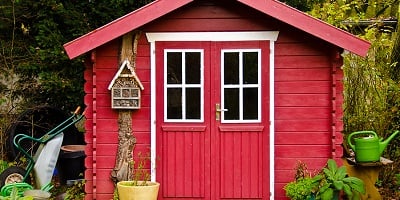 Whether a customer needs a basic shed to store tools or hopes to use their garden shed as an office, the possibilities for a garden shed are endless. Here are a few considerations to take into account when you are planning a new garden shed for a client.
Whether a customer needs a basic shed to store tools or hopes to use their garden shed as an office, the possibilities for a garden shed are endless. Here are a few considerations to take into account when you are planning a new garden shed for a client.
What to Consider When Designing a Shed
Before committing to a design, we recommend sitting down with your client to determine exactly what they will use their shed for and how their needs can be met. A shed designed to store tools and gardening equipment will be a much different project than one that will be used as an office or lounge.
Size: One of the most important considerations for shed building is size—build too small and your client will not have room to store additional items such as tools or expand their hobby if the shed is being used for fun. On the other hand, a shed that is too large can dwarf a yard, making it look like it is out of place.
Location & Foundation: You will also want to be sure to discuss the proposed location of the shed with your client. A level location away from wet, low-lying areas is essential for a shed. Additionally, as with all construction, a proper foundation is key to making sure the shed is well-supported and protected from ground moisture.
Utilities: Depending on how the shed will be used, utilities such as electricity, heating/cooling, and water can be installed. If a customer intends to use their shed as an office or lounge, lights and electrical outlets are non-negotiable. However, a tool shed can also benefit from outlets that can be used to charge tools and equipment. To ensure safety, all outlets in the shed must be GFCI protected, and the electrical cable running from the home must be encased through a PVC conduit buried at least 18 inches deep.
Gardeners will appreciate a water faucet, eliminating the need to wrestle with a hose, that can be used to water plants, clean tools, and wash their hands. If the faucet will be used during the winter months, the water supply pipe must be buried beneath the frost line to ensure it does not freeze from the cold weather.
Doors & Windows:The door size will also be dictated by the shed’s function. Wide, double doors with an entry ramp beneath them are great for customers who want to park a ride-on lawn mower in their shed. For customers who do not have large tools, a 32-inch door, like those found in homes, may work well.
Finally, we recommend including at least one functional window that can be opened for any garden shed. Not only does it provide natural light, but it can also provide some ventilation during the hot summer months.
Choosing Materials
It is always best to steer customers toward high-quality, durable materials that can withstand the elements and take a beating if the shed is being used to store lawn mowers and other yard equipment.
For framing, pressure-treated lumber can be a great upgrade to standard framing lumber if your client’s shed is in a wet climate, as it is treated to prevent rot. Additionally, exterior-grade plywood can be a great choice for the shed walls as it is even more water resistant than pressure-treated lumber. In general, we recommend steering a client toward materials that are durable and rot resistant as this will save money on future maintenance costs.
Another key element to the shed is the roof. Traditional asphalt shingles can be used on a shed, but customers who are seeking something more durable should consider installing a metal roof on their shed. Metal roofs have a longer lifespan than asphalt roofs and have better insulation properties as well. Perfect for a shed that is going to be used as an office or hobby room.
SCRAIL® ROOFLOC® by BECK
Developed by BECK, the SCRAIL® ROOFLOC® Metal Roofing System makes installing metal roofing and facades quicker and more efficiently than ever before. Eight times as fast as bulk screws and twice as fast as collated screws, the SCRAIL® ROOFLOC® System is the fastest metal roofing system on the market. To learn more about how you can incorporate this system into your business, download our Metal Roofs Whitepaper today and see how increasing your roofing efficiency can help you grow your business.
.svg.png)

